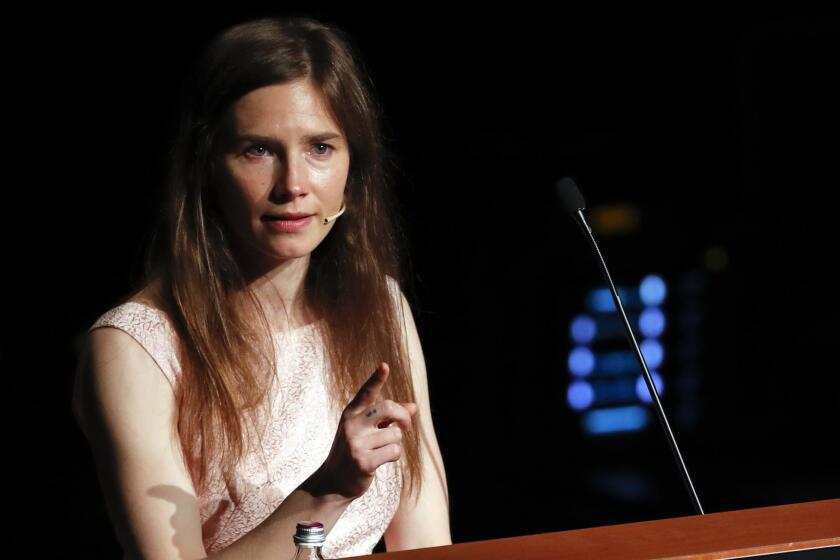Hans Asperger’s complex Nazi history
- Share via
What we now call autism has surely been a part of the human condition for as long as human beings have existed. But the way different cultures understand, talk about and treat people who exhibit the symptoms of autism — difficulty or disinterest in social interactions, repetitive behaviors and language impairments — can vary widely. After all, writes historian Edith Sheffer, “diagnoses reflect a society’s values, concerns, and hopes.” In “Asperger’s Children: The Origins of Autism in Nazi Germany,” Sheffer tells the story of the Hans Asperger, a child psychiatrist in Austria whose work before and during the Third Reich led to a broader definition of autism.
For decades, Asperger’s syndrome was the label given to children like those he had treated at the University of Vienna’s Children’s Hospital. Far from the much more severely affected patients described by Leo Kanner, the Johns Hopkins psychiatrist who first wrote about autism in the United States, these children were often intelligent, even brilliant. The idea that autism could mean difference rather than disorder, that neurodiversity could represent a source of strength, stemmed in part from his work in curative education, a field that came from the cosmopolitan, leftist milieu of Vienna between the world wars. Because he emphasized the value of treating the whole child and respecting individual children’s differences, Sheffer notes, “Asperger is often portrayed as a champion of neurodiversity.”
For the record:
7:25 p.m. June 15, 2018An earlier version of this review misspelled the last name of a co-author of “In a Different Key” as Donovan. He is John Donvan. The review previously said that book characterized Asperger as “a Nazi”; that has been updated to “likely a Nazi sympathizer.”
And yet, Sheffer goes on, “it is time to consider what Asperger actually wrote and did in greater depth.” In this compact, restrained and ultimately devastating book, Sheffer does just that. A shy and bookish child, Hans Asperger grew up to love science and nature, hiking and mountain-climbing, and the conservative Catholicism of his youth. He attended medical school in Vienna, which World War I had left “a cauldron of social upheaval, political strife, and economic catastrophe.” A progressive welfare state sought to improve citizens’ lives through improvements in public housing, education, and healthcare. Alongside what reformers lauded as “positive” eugenics, of course, came the negative variety: even before the Germans occupied Austria, officials there were advocating for the sterilization of “the inferior.”
Children’s Hospital, where Asperger was beginning to climb the professional ladder, was taken over by a Nazi sympathizer in 1929. Jewish doctors were purged and liberals resigned, but Asperger remained. In the years to come, he began writing of the children he encountered, children who were different, special, unique. But what matters in an authoritarian nation is conformity. Under Nazi rule, the remedies for nonconformity were separation, torture and murder. While we’re all familiar with the Jewish populations killed in the Holocaust, along with the numbers of Roma, gay people and artists who were also killed by Hitler, a less well-known element of the Third Reich was its program of killing the disabled, including children.
They called it euthanasia, even though, Sheffer points out, “most of the children who were killed were not terminally ill, and could have led full lives.” The point wasn’t to mercifully end suffering, instead, “doctors in the program condemned children who they said would become a drain on the sate and/or endanger the gene pool of the German Volk.” In addition to the Jewish children killed, thousands of other children were euthanized during the Nazi era for their alleged unfitness. In Vienna, the killings were done at Spiegelgrund, a “Youth Welfare Institution” founded in 1940. “At least 789 children died there during the Third Reich,” Sheffer writes, “with the official cause of death for almost three-quarters of them listed as pneumonia.” The real weapons, it turns out, were barbituates and a special diet designed to starve a child slowly to death. Many children were sent to Spiegulgrund and not selected for euthanasia, but that doesn’t mean they weren’t hurt.
Some of the children sent to Spiegelgrund were born blind, missing limbs, or with Down syndrome. Others were suspected of having intellectual disabilities after seizures or other illnesses. Still others were there because they seemed disconnected from society, unable to fit in, lacking in what the Germans call “gemüt,” a difficult-to-define term signifying spiritual connection with the group. Some had been delivered to the institution by their parents, others taken by the authorities.
The chapters in which Sheffer describes what the children endured are difficult to read — there is torture of both body and soul — but she writes with extraordinary sensitivity and an understated grace. A historian of Germany and modern Europe, Sheffer’s research is meticulous and wide-ranging. As the mother of a son diagnosed with autism at 17 months to whom the book is dedicated, her personal connection to autism is powerfully felt throughout the work but not directly mentioned until the acknowledgements.
“It is difficult to reconcile Asperger’s role in the child euthanasia program with his well-known support for children with disabilities,” Sheffer writes. “Both are in the documentary record.” She is not the first author to address Asperger’s role. Recently, two new books tracing the history of autism — “In a Different Key: The Story of Autism,” by John Donvan and Caren Zucker, and Steve Silberman’s “Neurotribes: The Legacy of Autism and the Future of Neurodiversity” — raised the question of Asperger’s complicity in the Nazi death machine at Spiegelgrund. Silberman presented a nuanced view of the doctor as a man whose work took place amid a moral quagmire; he may have sent some children to their deaths, but he saved those he could. For Donvan and Zucker, the verdict is more absolute: Although his descendants vehemently deny it, citing his passionate Catholicism, Asperger was likely a Nazi sympathizer, working alongside Nazis, in a system that killed children.
In the end, “Asperger’s Children” isn’t as concerned about the doctor’s individual culpability as it is about the way we treat differences, beginning with how we label them. The syndrome bearing Asperger’s name was added to the Diagnostic and Statistical Manual of Mental Disorders in 1994, then removed it in 2013. The current edition bundles together several characteristics into one blanket term: Autism Spectrum Disorder. Either definition, Sheffer points out, has the power to make services more or less widely availability, and to skew how we view people who are diagnosed autistic. Her book is “a cautionary tale,” Sheffer writes, “revealing the extent to which diagnoses can be shaped by social and political forces, how difficult those may be to perceive, and how hard they may be to combat.”
Tuttle is the president of the board of the National Book Critics Circle.
::
“Asperger’s Children: The Origins of Autism in Nazi Vienna”
Edith Sheffer
W.W. Norton: 320 pp., $27.95
Tuttle is the president of the National Book Critics Circle.
More to Read
Sign up for our Book Club newsletter
Get the latest news, events and more from the Los Angeles Times Book Club, and help us get L.A. reading and talking.
You may occasionally receive promotional content from the Los Angeles Times.










